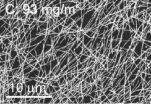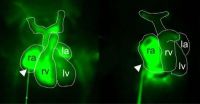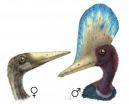(Press-News.org) Scientists at The University of Texas MD Anderson Cancer Center have discovered the signaling pathway whereby a master regulator of cancer cell proteins – known as Src – leads to ovarian cancer progression when exposed to stress hormones. The researchers report in the current issue of Nature Communications that beta blocker drugs mitigate this effect and reduce cancer deaths by an average of 17 percent.
Src (pronounced "sarc," short for sarcoma) is a proto-oncogene – a normal gene that can become an oncogene due to increased expression – involved in the regulation of cell growth and division. Known to be instrumental to changes that cause normal cells to go awry, this study sheds light on its functional role as a key molecular switch affecting a downstream signaling pathway that spurs disease progression.
Led by Anil K. Sood, M.D., professor in MD Anderson's Departments of Gynecologic Oncology and Cancer Biology, researchers found that noradrenaline (NA; a stress hormone) directly affects tumor growth and spread through beta-adrenergic (ADRB) receptors expressed on tumor cells. The study demonstrated that ADRB signaling leads to Src activation via a unique protein kinase A (PKA)-mediated mechanism, which is critical to the regulation of cellular activity and cancer metastasis. This is the first time that scientists have been able to show that ADRB receptors play a direct role in Src activation by this mechanism.
"When Src is triggered by stress, it works like a dam letting out water that causes a flood downstream. Src, like the dam, is a master regulator switch that causes a chain reaction in the cells," said Sood.
Based on existing findings of Sood's ongoing work exploring potential interventions against the effects of stress, the researchers examined data on outcomes of cancer patients treated with beta blocker drugs from the U.S. Food and Drug Administration Adverse Event Reporting System. They found that mortality in patients treated with a beta blocker was reduced by an average of 17 percent across all major cancer types. Moreover, they observed a nearly 15 percent decrease in mortality among patients with ovarian and cervical cancer.
Beta blockers, also called beta-adrenergic blocking agents, treat a variety of conditions, such as heart disease, high blood pressure, glaucoma and migraines. They act on the ADRB receptors, which are also found on the heart – causing the heart to beat harder and faster under stress – and are involved in maintaining blood flow.
When the ADRB receptors on cancer cells are activated, they set into motion a chain of events that leads to formation of new blood vessels that feed tumor growth – a process known as angiogenesis. New blood vessel formation allows tumors to grow and spread more rapidly. Beta blocking agents stop this process.
"Prior to our work, the concept of stress hormones driving cancer growth was very new and only very limited information about the effect of beta blockers on cancer outcomes in humans has been available," said Guillermo Armaiz-Pena, Ph.D., instructor of Gynecologic Oncology and Reproductive Medicine and first author of the study. "This study provides incentive to further explore beta blockers as a possible supplement to traditional cancer therapies."
A Mystery Pathway Revealed
While NA – the most abundant stress hormone in the ovary – has been proven to modulate multiple cellular functions important for cancer progression, how it does so had remained a puzzle. Sood's team used a multi-step process to determine how the tumor microenvironment is disrupted by stress hormones.
First, the researchers exposed ovarian cancer cells to NA and identified a number of proteins altered by stress hormones. Using bioinformatics analysis, they narrowed potential mediators to Src.
A series of subsequent experiments designed to verify the biological roles of Src in promoting ovarian cancer tumor growth in response to stress hormones revealed the signaling pathway involved in NA-mediated Src activation. Specifically, they showed:
PKA (also known as cAMP-dependent protein kinase) is the switch that "turns on" NA-induced Src activation;
The signaling pathway occurs at a particular site on the cell known as S17; and
This specific mechanism is key to mediating ADRB/cAMP/PKA-induced Src activation.
Building on the Stress-Cancer Connection
For the past 13 years, Sood's research efforts have focused on the effects of chronic stress on cancer metastasis. The latest study helps form a more comprehensive picture on the impact of and biological mechanics of chronic stress on ovarian cancer, as well as the role of beta blockers in slowing disease progression. Previous studies have shown:
Chronic stress triggers a chain of molecular events that protects breakaway ovarian cells from destruction, as heightened levels of the fight-or-flight hormones epinephrine and norepinephrine permit more malignant cells to safely leave the primary tumor – a necessary step in metastasis and cancer progression.
When mice with ovarian cancer are stressed, their tumors grow and spread more quickly, but the effect can be blocked using propranolol, a beta blocker commonly prescribed for heart disease.
Future research will focus on other biological mechanisms that may be affected by stress. Eventually, Sood hopes his studies will help identify the cancer patients most likely to benefit from beta blockers and other stress interventions. He is also looking at the impact of stress on other diseases, such as gastrointestinal disorders.
"This is a major step forward in understanding the biology and impact of stress on cancer progression and it opens the door to study drugs that could inhibit this unique signaling pathway," Sood said.
### The current study was supported by grants from the NCI (F31CA126474), NIH (numbers CA101642, CA140933, CA104825, CA110793, CA109298, P50CA083639, P50CA098258, CA128797, RC2GM092599, U54CA96300, and U54CA96297), the Ovarian Cancer Research Fund, Zarrow Foundation, Department of Defense (numbers OC073399, W81XWH-10-1-0158, OC100237, and BC085265) Betty Ann Asche Murray Distinguished Professorship, the Marcus Foundation, RGK Foundation, Gilder Foundation, the estate of C.G. Johnson Jr., the Laura and John Arnold Foundation and the Blanton-Davis Ovarian Cancer Research Programme.
Co-authors of the paper from MD Anderson included Guillermo N. Armaiz-Pena Ph.D.; Julie K. Allen; Rebecca L. Stone, M.D.; Alpa M. Nick, M.D.; Yvonne G. Lin, M.D.; Liz Y. Han, M.D.; Lingegowda S. Mangala; Gabriel J. Villares; Pablo Vivas-Mejia, Ph.D.; Christian Rodriguez, Ph.D.; Archana S. Nagaraja; Kshipa M. Gharpure; Mian M.K. Shazhad, M.D.; Maya Zigler; Michael T. Deavers, M.D.; Gary E. Gallick, Ph.D; Menashe Bar-Eli, Ph.D.; and Gabriel Lopez-Berestein, M.D. Sood, Allen, Villares, Nagaraja, Gharpure and Zigler are also affiliated with The University of Texas Health Science Center. Other co-authors included Madeline Torres-Lugo, Ph.D., Gustavo E. Lopez, Ph.D. and Anthony Cruz, University of Puerto Rico; Zheng Wu, Ph.D., Robert D. English, Ph.D., Kizhake V. Soman, Ph.D. and John E. Wiktorowicz, Ph.D., University of Texas Medical Branch; Alexander Zien, Ph.D., Theodoros G. Soldatos and David B. Jackson, Molecular Health GmbH; Tom Young, Ph.D., Lehman College; Koen De Geest, M.D. and Susan K. Lutgendorf, Ph.D., University of Iowa; Steve W. Cole, Ph.D., University of California, Los Angeles.
Preclinical study identifies 'master' proto-oncogene that regulates ovarian cancer metastasis
Beta blockers inhibit cancer progression, decrease mortality
2013-01-29
ELSE PRESS RELEASES FROM THIS DATE:
Medical societies unite on patient-centered measures for nonsurgical stroke interventions
2013-01-29
FAIRFAX, Va.—The first outcome-based guidelines for interventional treatment of acute ischemic stroke—providing recommendations for rapid treatment—will benefit individuals suffering from brain attacks, often caused by artery-blocking blood clots. Representatives from the Society of Interventional Radiology and seven other medical societies created a multispecialty and international consensus on the metrics and benchmarks for processes of care and technical and clinical outcomes for stroke patients.
In February, the guidelines will be published first in SIR's Journal ...
New options for transparent contact electrodes
2013-01-29
This press release is available in German.
Found in flat screens, solar modules, or in new organic light-emitting diode (LED) displays, transparent electrodes have become ubiquitous. Typically, they consist of metal oxides like In2O3, SnO2, ZnO and TiO2.
But since raw materials like indium are becoming more and more costly, researchers have begun to look elsewhere for alternatives. A new review article by HZB scientist Dr. Klaus Ellmer, published in the renowned scientific journal Nature Photonics, is hoping to shed light on the different advantages and disadvantages ...
Epigenetic control of cardiogenesis
2013-01-29
This press release is available in German.
Many different tissues and organs form from pluripotent stem cells during embryonic development. To date it had been known that these processes are controlled by transcription factors for specific tissues. Scientists from the Max Planck Institute for Molecular Genetics in Berlin, in collaboration with colleagues at MIT and the Broad Institute in Boston, have now been able to demonstrate that RNA molecules, which do not act as templates for protein synthesis, participate in these processes as well. The scientists knocked down ...
New insights into conquering influenza
2013-01-29
As influenza spreads through the northern hemisphere winter, Dr Linda Wakim and her colleagues in the Laboratory of Professor Jose Villadangos from the Department of Biochemistry and Molecular Biology, and the Department of Microbiology and Immunology, believe they have a new clue to why some people fight infections better than others.
The lab has been investigating the 'defensive devices' contained within the T- cells that are located on exposed body surfaces such as skin and mucosal surfaces to ward off infection. T-cells detect cells infected with viruses and kill ...
Survival of the prettiest: Sexual selection can be inferred from the fossil record
2013-01-29
Detecting sexual selection in the fossil record is not impossible, according to scientists writing in Trends in Ecology and Evolution this month, co-authored by Dr Darren Naish of the University of Southampton.
The term "sexual selection" refers to the evolutionary pressures that relate to a species' ability to repel rivals, meet mates and pass on genes. We can observe these processes happening in living animals but how do palaeontologists know that sexual selection operated in fossil ones?
Historically, palaeontologists have thought it challenging, even impossible, ...
New insights into managing our water resources
2013-01-29
Dr Tim Peterson, from the School of Engineering at the University of Melbourne has offered new theories that will lead to a deeper knowledge of how water catchments behave during wet and dry years. His research was published recently in the leading international hydrology journal "Water Resources Research" and was selected by the American Geophysical Union as a highlight of the society's 13 international journals.
Dr Peterson's work shows that some catchments have a finite resilience to wet and dry years because they have two steady states. The traditionally held view ...
Study reveals 2-fold higher incidence of non-melanoma skin cancers for HIV patients
2013-01-29
OAKLAND, Calif., January 29 — HIV-positive patients have a higher incidence of non-melanoma skin cancers, according to a Kaiser Permanente study that appears in the current online issue of the Journal of the National Cancer Institute. Specifically, basal cell and squamous cell carcinomas occur more than twice as often among HIV-positive individuals compared to those who are HIV-negative.
The study cohort of 6,560 HIV-positive and almost 37,000 HIV-negative subjects was drawn from members of Kaiser Permanente Northern California from 1996 to 2008.
Overall, HIV-positive ...
Indoor air puts Chinese women nonsmokers at risk
2013-01-29
BUFFALO, N.Y. – The hazards of breathing outdoor air in some Chinese cities have been well-documented. Now a University at Buffalo study confirms that breathing indoor air also carries significant cancer risks, especially for Chinese women.
The UB study, published online this month, in the journal Cancer Causes & Control, found that indoor air pollution that generates fine particulate matter is a key contributor to the high rates of lung cancer among Chinese women, despite the fact that few of them smoke.
The research found indoor particulate matter levels that are ...
Researchers generate a mutant mouse model useful in the treatment of neuromuscular diseases
2013-01-29
In three to six months of life, this genetic alteration in mice –similar to that occurred in human– causes a rapid degeneration in the lower limbs to death for cardiac arrest.
For the first time in the world, researchers at the Center for Biomedical Research of the University of Granada have created mice with a genetic mutation inducing a deficiency in the coenzyme Q10, a rare mitochondrial disease prevailingly affecting children. These mutant mice –which lack the Coq9 gene– will be "a valuable tool for the study and treatment of metabolic encephalopathies and neuromuscular ...
Center-based child care: Long hours do not cause aggression and disobedience
2013-01-29
Spending many hours in centre-based child care does not lead to more aggression and disobedience in children, according to a new study using data from the Norwegian Mother and Child Cohort Study (MoBa).
Data from 72,000 mothers and their children, including siblings, were obtained from MoBa. Using questionnaires, mothers were asked about aggression and obedience at both 18 and 36 months and the amount of time their children spent in child care. In addition to comparing children from different families, the researchers compared siblings who had different amounts of child ...
LAST 30 PRESS RELEASES:
Although public overwhelmingly supports hepatitis B vaccine for a newborn, partisan differences exist
DFW backs UTA research to bolster flood resilience
AI brain scan model identifies stroke, brain tumors and aneurysms – helping radiologists triage and speed up diagnoses
U.S. News & World Report gives Hebrew Rehabilitation Center highest rating
Optica and DPG name Antoine Browaeys 2026 Herbert Walther Award recipient
The presence of a gun in the home increases the risk of suicide by three to five times
PFAS exposure and endocrine disruption among women
Vaccines and the 2024 US presidential election
New approach narrows uncertainty in future warming and remaining carbon budget for 2 °C
When pregnancy emergencies collide with state abortion bans
American College of Cardiology supports front of package nutrition labeling
This fossil bird choked to death on rocks, and no one knows why
An iron-on electronic circuit to create wearable tech
When you’re happy, your dog might look sad
Subnational income inequality revealed: Regional successes may hold key to addressing widening gap globally
Protein puppeteer pulls muscle stem cells’ strings
Study: A genetic variant may be the reason why some children with myocarditis develop heart failure, which could be fatal
Social justice should not be tokenistic but at the heart of global restoration efforts
A new kind of copper from the research reactor
Making simulations more accurate than ever with deep learning
Better predicting the lifespan of clean energy equipment, towards a more efficient design
Five ways microplastics may harm your brain
Antibody halts triple-negative breast cancer in preclinical models
Planned birth at term reduces pre-eclampsia in those at high risk
Penguins starved to death en masse, study warns, as some populations off South Africa estimated to have fallen 95% in just eight years
New research explains how our brains store and change memories
Space shuttle lessons: Backtracks can create breakthroughs
New study finds cystic fibrosis drug allows patients to safely scale back lung therapies
From field to lab: Rice study reveals how people with vision loss judge approaching vehicles
Study highlights underrecognized link between kidney disease and cognitive decline
[Press-News.org] Preclinical study identifies 'master' proto-oncogene that regulates ovarian cancer metastasisBeta blockers inhibit cancer progression, decrease mortality



